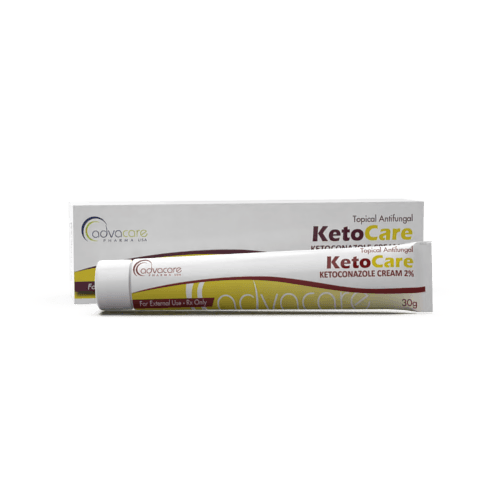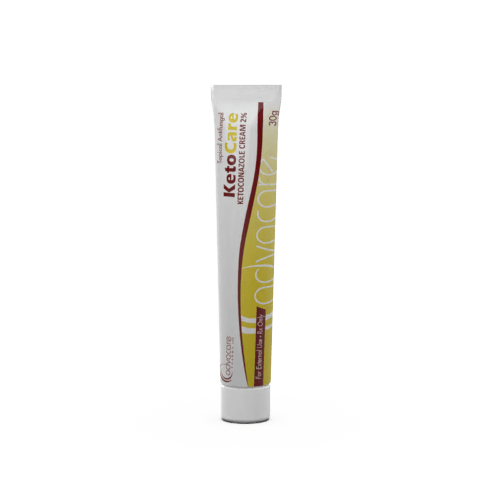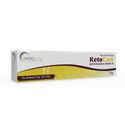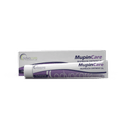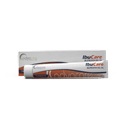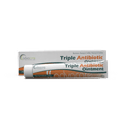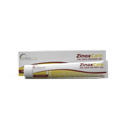- Home›
- Pharmaceuticals›
- Topicals›
- Medical Gels›
- Ketoconazole Cream
Ketoconazole Cream
Form
Dosage
Packaging
What is Ketoconazole?
Active Ingredients: Ketoconazole
Ketoconazole Cream is a topical antifungal drug used to treat skin infections such as athlete's foot (tinea pedis), jock itch (tinea cruris), and ringworm (tinea corporis). It is also indicated for the treatment of candidiasis and seborrheic dermatitis. This cream should only be applied to the skin.
This medication is a first-choice topical treatment for tinea corporis or tinea cruris.
Ketoconazole belongs to the class of medicines known as azole antifungals. It works by slowing the growth of fungi that cause infection. Ketoconazole displays fungistatic activity against susceptible microorganisms and is effective against dermatophytes such as Epidermophyton floccosum, Microsporum audouini, M. canis, M. gypseum, Trichophyton mentagrophytes, T. rubrum, and T. tonsurans. It is also active against Candida albicans, C. tropicalis, and Malassezia furfur (Pityrosporum orbiculare, P. ovale).
Ketoconazole is produced as a sterile cream or gel. This medication is available for distribution in a range of tube sizes including 15g, 30g, and 60g.
AdvaCare Pharma is a GMP-certified producer and supplier of Ketoconazole Cream. We offer a wide range of high-quality and cost-effective medications that are available for distribution. Our pharmaceutical products are manufactured in our GMP-certified facilities in China, India, and the USA.
Why are we a top Ketoconazole manufacturer?
AdvaCare Pharma is a US pharmaceutical company that manufactures Ketoconazole Cream, and our entire range of 50+ topical treatments in cream, ointment and gel dosage forms, under stringent GMP regulations. Our distinctive approach to business fosters a highly collaborative relationship with our pharmaceutical distributors. For the past 20 years we have established a reputation as a trusted Ketoconazole manufacturer, one of the 500+ pharmaceutical products in our comprehensive range, across more than 65 global markets.
Uses
What is Ketoconazole used for?
It is used to treat fungal or yeast infections of the skin, such as:
- candidiasis due to Candida albicans
- seborrheic dermatitis
- athlete's foot (tinea pedis) or jock itch (tinea cruris) due to Epidermophyton floccosum, Trichophyton mentagrophytes, or T. rubrum
- ringworm (tinea corporis)
- pityriasis (tinea versicolor) due to Malassezia furfur (Pityrosporum orbiculare or P. ovale)
How is Ketoconazole Cream used?
This medication is manufactured as a sterile cream. This product is intended for topical administration directly to the skin. Do not apply this medication to the eyes, nostrils, mouth, or vagina.
Always wash hands with soap and water before and after using this medication. It is recommended to wash and completely dry the affected area before applying the cream. After application, the afflicted area should not be covered by bandages or dressings unless otherwise indicated by a healthcare professional. The afflicted area should not be submerged in water for 3 hours after application.
It is common to see an improvement in symptoms shortly after beginning treatment, so is important to note that treatment should not be discontinued early. If symptoms do not improve after treatment, a doctor should be consulted, and the patient should be re-evaluated.
Is it recommended to apply Ketoconazole Cream on broken or infected skin?
This product should not be used on skin that has cuts, scrapes, or burns. In the event that the cream gets on broken skin, the area should be rinsed right away. It is advised to consult a doctor before applying Ketoconazole Cream to any broken or infected skin.
How should Ketoconazole Cream be stored?
When not in use, the tube should be tightly closed and stored in a dark location at room temperature (20-25°C). Do not keep this product in cold temperatures or direct light.
What happens if a dose is missed?
In the event of a missed or forgotten dose, the medicine should be applied as soon as possible. The missed dose should be skipped if it is nearly time for the next dose. Do not apply two doses at the same time.
What dose should be applied?
Adult Dosing Dosage may vary based on different medical indications:
- For cutaneous candidiasis, the cream/gel should be applied to the afflicted area 1-2 times per day. Treatment should continue for 2 weeks.
- For non-scalp seborrheic dermatitis, a thin layer of cream/gel should be applied to the afflicted area. It should be applied twice a day for 4 weeks.
- For tinea corporis, a thin layer of cream/gel should be applied to the afflicted area. It should be applied once per day for 2 weeks.
- For tinea cruris, a thin layer of cream/gel should be applied to the afflicted area. It should be applied once per day for 2 weeks.
- For tinea pedis, a thin layer of cream/gel should be applied to the afflicted area. It should be applied once per day for 6 weeks. Moccasin-type (dry-type) infections may require a longer duration of treatment.
- For tinea versicolor, a thin layer of cream/gel should be applied to the afflicted area once or twice per day. Treatment should continue for 2 weeks.
- For tinea faciale, a thin layer of the cream should be applied once per day. Treatment should continue for 2 weeks.
- For tinea nigra, a thin layer of the cream should be applied once per day. Treatment should continue for 2 weeks.
Pediatric Dosing Recommended dosage for children may vary based on different medical conditions:
- For non-scalp seborrheic dermatitis in children or adolescents, a thin layer of cream/gel should be applied to the afflicted area. It should be applied twice a day for 4 weeks.
- For tinea capitis (adjunct treatment) in children, a thin layer of cream should be applied once per day. Treatment is recommended for 1 week.
- For tinea corporis in children or adolescents, a thin layer of cream/gel should be applied to the afflicted area. It should be applied once per day for 2 weeks.
- For tinea cruris in children or adolescents, a thin layer of cream/gel should be applied to the afflicted area. It should be applied once per day for 2 weeks.
- For tinea faciale in children or adolescents, a thin layer of the cream should be applied once per day. Treatment should continue for 2 weeks.
- For tinea pedis in children or adolescents, a thin layer of cream/gel should be applied to the afflicted area. It should be applied once per day for 6 weeks. Moccasin-type (dry-type) infections may require a longer duration of treatment.
- For tinea versicolor in children or adolescents, a thin layer of cream/gel should be applied to the afflicted area once or twice per day. Treatment should continue for 2 weeks.
Refer to a doctor or healthcare professional for the exact dosage and duration of treatment.
Who can use Ketoconazole?
Ketoconazole Cream can be given to adults and children, but caution is advised for specific groups of patients.
Pregnant Ketoconazole Cream is considered safe for use by pregnant women. Fetal harm is not expected, as this medication is not typically absorbed.
Breastfeeding Ketoconazole Cream is generally considered safe for use by breastfeeding women; however, it is unknown whether this medication is absorbed in quantities that are detectable in milk. Treatment of the breast should be avoided while nursing.
Children Topical ketoconazole is considered safe for use by pediatric patients over 12 years old. The safety and effectiveness of this medication have not been established for children under 12 years old.
Geriatric There have not been sufficient studies concerning the use of this medicine in elderly patients. It should be noted that some elderly patients may be more sensitive to side effects.
Side Effects
As with all pharmaceuticals, some unwanted effects can occur from the use of Ketoconazole Cream.
Common side effects include, but may not be limited to:
- mild irritation, burning, or stinging
- mild itching
- dry skin
Serious side effects may include:
- allergic reactions
- shortness of breath
- burning, stinging, or severe irritation
- redness or oozing of the afflicted skin
For a comprehensive understanding of all potential side effects, consult a medical professional.
If any symptoms persist or worsen, or you notice any other symptoms, please call your doctor.
Precautions
Do NOT use Ketoconazole Cream if:
- You are hypersensitive to any of the other ingredients.
- You are hypersensitive to sulfites when applied topically.
Before treatment, consult your doctor regarding any medications you are taking to address potential drug interactions.This medicine is known to interact with medicines such as topical aminolevulinic acid.
This medication may not be suitable for people with certain conditions, so it is important to consult with a doctor if you have any health conditions. Special considerations or modified treatment plans may be necessary for those with conditions such as asthma, sulfite allergies, or a history of allergic reactions to other antifungal medications (e.g. clotrimazole, econazole, or miconazole).
Topical ketoconazole may increase sensitivity to light. It is recommended to avoid sunlight and artificial UV light while undergoing treatment with this medication.
Some topical ketoconazole products are flammable. It is important to avoid fire or smoking during and immediately after applying the medication.
Some topical ketoconazole products may contain sodium sulfite, which may cause hypersensitivity or allergic reactions in some susceptible individuals.
During treatment, it is advised to avoid covering treated skin with tight-fitting or synthetic clothing. When treating the feet, it is recommended to wear cotton socks or sandals/shoes with adequate air circulation.
It is recommended to avoid using skin products that cause irritation (e.g. harsh soap, hair dye, hair removers) or skin products made with substances such as alcohol, lime, or astringents).
References
Double-blind treatment of seborrheic dermatitis with 2% ketoconazole cream
This is a double-blind study, in which thirty-seven patients with seborrheic dermatitis were treated topically with either a 2% ketoconazole cream or a vehicle control.
The patients were examined for the presence of Malassezia ovalis (Pityrosporum ovale) cells in their scalp scales, with changes in yeast cell numbers and morphology of M. ovalis recorded, alongside clinical evaluations of improvement.
The results showed that 2% ketoconazole cream, unlike the placebo cream, effectively reduced the number of viable yeast cells on the scalp. Patients treated with ketoconazole had 75%–95% improvement, compared to only three out of seventeen patients treated with the placebo cream.
The conclusion is that ketoconazole can be beneficial in the treatment of seborrheic dermatitis.
Topical 2% ketoconazole cream monotherapy significantly improves adult female acne: A double-blind, randomized placebo-controlled trial
Ketoconazole can be beneficial as a topical antifungal and anti-inflammatory drug in decreasing the lipase activity of Cutibacterium acnes in vitro.
This double-blind, randomized placebo-controlled trial evaluated the efficacy of this cream in females with mild adult female acne. Patients used a ketoconazole 2% cream or a placebo cream twice daily for 10 weeks. This trial included 41 participants in which there was an assessment of the improvement of clinical severity, measured by the AFA score graded by investigators and participants, and the change in acne count.
Participants with acne improvement from baseline was significantly higher in the ketoconazole group compared to the placebo group (42.9% vs. 9.5%, P = 0.015), as was the success rate (45.0% vs. 14.3%, P = 0.043). The most common side effects were dryness and itching.
The conclusion of this study is that monotherapy of ketoconazole demonstrated a promising effect in improving acne with an excellent safety profile and it should be considered as a treatment drug for acne in females.
You might be interested in...
Why AdvaCare Pharma?
As an industry leader, we are aware of our responsibility to provide affordable and sustainable solutions to improve healthcare worldwide.
